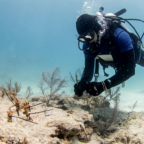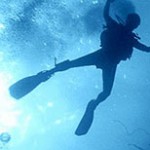
In between the sunlit shallows and the dark, deep ocean lies an inky realm where few people have ever been. Stretching from about 30 to 150 metres, the mesophotic zone (meaning “middle light”) is an awkward depth. It lies just beyond the reach of regular scuba divers and it’s usually what aquanauts inside multimillion-dollar submersibles merely glimpse as they plunge deeper.
However, a new generation of scientists is pushing the limits of diving to discover the secrets of this ecological zone. “There’s so much to see, and everything seems new,” says Erika Gress from James Cook University in Queensland, Australia. “It’s like a different world.”
To access the mesophotic zone, divers use equipment called rebreathers, which don’t exhale bubbles. “It’s so quiet,” says Kylie Lev, assistant curator at the Steinhart Aquarium at the California Academy of Sciences in San Francisco. “I think it’s the only time in my life that I feel like there’s just an absence of noise.”
A rebreather unit is usually a black or yellow box mounted on a diver’s back with a loop of pipe to breathe through. The device recycles a diver’s exhalations, which still contain plenty of breathable oxygen. It adds more oxygen as needed and filters out carbon dioxide.
The setup is efficient and can keep a diver breathing for eight hours, although dives generally last four or five. Most of that time is spent coming up slowly to avoid getting decompression sickness – or the bends – when dangerous gas bubbles form in the body, like opening a shaken can of beer.
Deep-diving scientists also breathe a special mix of gases because the amount of oxygen in normal air becomes toxic below 60 metres. “If you breathe too much oxygen too deep you can pass out, and when you pass out in the water, you drown,” says Luiz Rocha, the curator of fishes at California Academy of Sciences. Nitrogen also becomes debilitatingly narcotic. To avoid those effects, some of the oxygen and nitrogen is replaced by helium, which isn’t poisonous.
Helium is expensive – all the more reason for using a rebreather. If you filled a regular scuba tank with this helium mix and dived to 150 metres, Rocha says, “you’d be spending $20 (£16.50) in every breath”.
Rebreathing apparatus has been around since the late 1870s, and was used by military frogmen during the second world war. “Mechanically and even electronically, rebreathers are very much the same as they were 50 years ago,” says Rocha. Rebreathers have a reputation for being dangerous, chiefly because the gas mix can be deadly if it isn’t right. But the computers that monitor and control gas levels have become more reliable.
“The most important thing when you’re diving on a rebreather is knowing how much oxygen you’re breathing at all times,” says Rocha. “We use a computer that sits right in front of our eyes.” That way there’s no risk of getting distracted chasing after a fish and forgetting about the oxygen levels. Even a minute or two breathing too much oxygen can be fatal.
Still, rebreather divers take down up to four or five bailout tanks – regular scuba tanks filled with different gas mixes – that they can use if their rebreather fails, giving them an emergency exit from the deep. “We’ve never had a bailout situation in our team,” says Rocha.
Safety requirements, especially for scientific divers, have also become more rigorous. It takes years to train and hundreds of hours of diving. Rocha likens it to learning to fly. “You can’t have one week of training then the next day go and fly your plane by yourself. You have to accumulate a certain number of hours flying with an instructor,” he says. “It’s the same thing with a rebreather.”
Preparation at the surface, assembling and checking the large amount of equipment before each dive, takes an hour, and it’s often the most physically and mentally challenging part of a dive. “The weight of all of your gear is real,” says Lev. “But there’s this moment for me every time I hop in the water that the pressure is lifted.”
Below the surface, the human body isn’t aware of the water crushing down. “You don’t feel any pressure,” says Gress. “I just find it mesmerising that we humans are able to have so much water above us.”
Divers who make it to the depths of the mesophotic zone are rewarded with sightings of fabulously colourful animals. Rocha has helped to name dozens of fish species including the Aphrodite anthias (Tosanoides aphrodite), with neon pink and golden markings, which he found 100 metres down at St Paul’s Rocks in the Atlantic Ocean off the coast of Brazil. “It hypnotised us,” he says.
Gress studies black corals in the mesophotic zone. “Everybody thinks they are dark creatures that live in caves, but not at all,” she says. The corals’ skeletons are black or dark brown, but their external, living tissue can be orange, white, red, green or yellow. “All the colours that you can imagine,” Gress says. Black corals grow as long spirals, wide fans, bushy shrubs and branching trees, five metres tall.
For Gress, descending to these depths is vital because in many parts of the world the jewellery industry has stripped black corals from shallow seas for their dense, precious skeletons.
“Nowadays, we can only find them beyond 40 or 50 meters,” she says. Compared with hard corals that form tropical coral reefs, little is known about black corals, which grow down to at least 9km and can live for more than 4,000 years, making them the oldest known colony-forming animals.
Rocha has tried using deep-diving submersibles for his fish studies, but says it was a nightmare. He compares it with studying birds in a rainforest using a helicopter: “It’s not the right tool for the job.”
Silently diving with rebreathers allows Rocha and colleagues to get close to fish, to photograph them and collect specimens in hand nets. “You can hear all of these small nuanced noises that animals make,” says Lev.
To describe a new species requires bringing back several specimens for museum collections. Rocha emphasises that these fish are not rare once you get down into their realm.
The team also uses a small decompression chamber to bring fish up alive, by slowly releasing the pressure over several days. “It unlocks a lot of doors for getting these animals to be strong ambassadors for their species,” says Lev.
Fish from the mesophotic zone have proven remarkably hardy and are surviving well at Steinhart Aquarium at the California Academy of Sciences. These fish are helping to show aquarium visitors that mesophotic reefs are unique, threatened and need just as much protection as shallow coral reefs, Lev says.
“Everybody assumed they could be a refuge,” says Rocha. But as his and other studies are showing, these depths are home to a different set of species. This won’t be somewhere that shallow species can retreat to escape from impacts above, such as overfishing and coral bleaching. And these deep reefs are not out of reach of human impacts. Rocha is soon to publish a study showing plastic pollution is often worse on mesophotic reefs than nearer the surface, likely because currents are weaker down there. “Plastics just sit there for longer,” he says.
Perhaps the most powerful thing that rebreathers allow is for scientists to safely explore more of the ocean than ever before in bubble-free tranquility. This is the closest humans can come to being a fish.
NOTE: This article was amended on 5 January 2023 to remove a statement that helium “doesn’t cause the bends”. Although it behaves differently to nitrogen and oxygen in the blood system, it can still contribute to decompression sickness.















Social Profiles